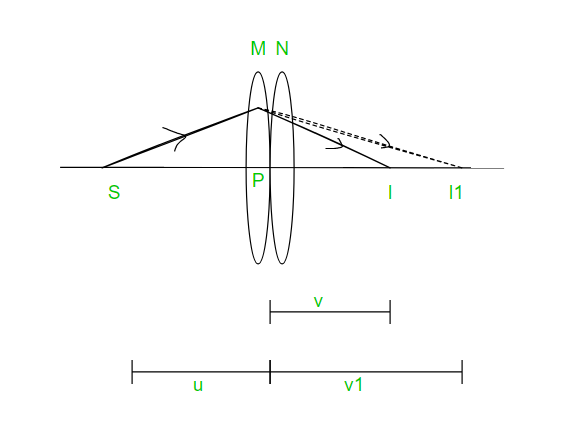镜头组合
光的行为和特性是在物理学的一个分支光学中研究的。射线光学,也称为几何光学,讨论了光以直线路径传播并且每个物体都有一个图像。光学仪器是利用镜子、透镜和棱镜的反射和折射能力创建的光学设备。
什么是镜头?
Lenses are basically magnifying lenses with curved sides. A lens is a piece of transparent glass that focuses or disperses light beams through refraction. Because of their magnifying properties, lenses are utilized in telescopes and other magnifying tools. They capture light beams and are utilized in cameras.
光线是由一组镜头而不是相机中的一个镜头收集的。镜头的放大倍率是生成的图片与目标大小的比例。镜头也可以成组使用,以减少它们产生的图像的模糊和失真。
因此,镜头是一种微小的材料,已被改变以使用光线捕捉图像。在这篇文章中,我们将介绍镜头公式、与之相关的术语,以及如何使用镜头公式来计算放大倍率。
用于镜头的术语
- 极点——极点是透镜球面折射面的中心。主轴与镜片表面相交的点。
- 光学中心 -光学中心是镜头中心的主轴上的点。
- 曲率中心——透镜有两个球面,它们一起形成一个球体。曲率中心是这些球体相交的点。
- 主轴——主轴是连接曲率中心和极点的假想线。
- 光圈——光圈是指镜片中适合折射的部分。镜头的孔径是其透光区域的有效直径。
- 焦点——平行于轴的准直光集中的点称为焦点。
- 焦距——镜头的焦距是其光学中心与其焦点或焦点之间的距离。
- 功率 -镜头的功率是其焦距的倒数。屈光度是 SI 的功率单位。
镜头类型
一个简单的镜头是一个单一的放大组件,但一个复合镜头是由几个沿公共轴对齐的简单镜头组成的。光学像差可以在简单镜头中看到,但在复合镜头中不存在。复合镜片的另一个好处是可以改变放大倍率以满足用户的需要。
根据镜片的形式和用途,它们分为两组:
- 凹透镜
A concave lens is one that has at least one side that curves inwards. A biconcave lens is a concave lens with both sides curled inward. Concave lenses are divergent lenses, which means that light rays refracted through them are stretched apart. They possess the capacity to diverge a parallel light beam. The margins of a concave lens are either broader than the centre or narrower than the centre.
凹透镜为观看者提供了较小的画面。穿过透镜后,平行于轴的光线似乎分散开来,这就是凹透镜的焦点。镜头的光学中心与焦点之间的距离称为焦距。
- 凸透镜
A lens having an outward curvature is known as a convex lens. In contrast to a concave lens, the thickness of a convex lens is greater in the centre than it is at the corners. Converging lenses are known as convex lenses. They can concentrate a parallel stream of light into a single point. The focus point of a convex lens is this location, and the focal length is the distance between the optical centre and the focal point. The focal point is located on the opposite side of the lens than the light beams.
平凸透镜是一侧平坦的凸透镜。人眼的晶状体是凸透镜的一个很好的例子。用于治疗远视或远视的放大镜是凸透镜的另一个例子。在相机中,凸透镜用于集中光线并提供清晰的图像。在显微镜和望远镜等放大设备中使用的复合透镜中也可以看到凸透镜。
接触式薄透镜组合
考虑两个镜头,M 和 N,焦距分别为 f 1和 f 2 。对象 S 放置在公共主轴上。第一个镜头 M 在 I 处创建图像,作为第二个镜头 N 的主体。如图所示,最终图片在 I 1处创建。

Let object distance for the first lens (M), PS be u, the final image distance, PI be v and the Image distance for the first lens (M), PI1 be v.
Now, for the image I1 produced by the first lens M, the lens formula can be written as:
1/v1 − 1/u = 1/f1 …. (1)
For the final image I, produced by the second lens N,
1/v − 1/v1 = 1/f2 …. (2)
Adding equations (1) and (2),
1/v − 1/u = 1/f1 + 1/f2 …. (3)
If the combination is replaced by a single lens of focal length F such that it forms the image of S at the same position I, then
1/v − 1/u = 1/F …. (4)
From equations (3) and (4),
1/F = 1/f1 + 1/f2
- where F is the focal length for the equivalent lens for the combination.
If n numbers of lenses are present, the equation can be written as:
1/F = 1/f1 + 1/f2 + ……. + 1/fn
But what happens if the lenses aren’t in contact?
The combined focal length may be determined using the following formula if the lenses are separated by a distance ‘d’.
1/F = 1/f1 + 1/f2 + ……. + d/fn
镜头组合的应用
镜头组合用于望远镜和显微镜,将两个或多个镜头组合起来:
- 获得物体的正像。
- 通过使用单个镜头,您可以减少发生的缺陷数量。
- 增加图像的放大倍数。
示例问题
问题1:焦距为9cm的凸透镜与焦距为19cm的凹透镜干涉。这个镜头组合的焦距是多少?
解决方案:
Given that,
f1 = +9 cm for convex lens,
f2 = −19 cm for concave lens.
The focal length of this combination is given by,
1/F = 1/f1 + 1/f2
1/F = 1/9 + 1/-19
1/F = 10/171
F = +17.1 cm
Hence, the total focal length of this combination is +17.1 cm.
问题2:8厘米的距离将两个焦距分别为12厘米和17厘米的窄凸透镜分开。组合的焦距是?
解决方案:
f1 = 12 cm,
f2 =17 cm
d = 8 cm.
The focal length of this combination is F, is given by
1/F = 1/f1 + 1/f2 – d/f1.f2
1/F = 1/12 + 1/17 – 8/12 × 17
= 1/12 + 1/17 – 2/51
= 7/68
F = 68/7
= 9.71 cm
Hence, the total focal length of this combination is 9.71 cm.
问题3:焦距为16cm的凹透镜与焦距为28cm的凸透镜接触的焦距是多少?系统的镜头是会聚的还是发散的?忽略镜片厚度。
解决方案:
Given,
The Focal length of convex lenses,
f1 = 28 cm
f2 = 16 cm
The Focal length of concave lenses,
f2 = -16 cm
From the formula,
1/f = 1/f1 + 1/f2
1/f = 1/28 – 1/16
f = -112/3
Substitute to get the answer as,
f = -37.3 cm
Hence, it is a diverging lens.
问题 4:两个度数镜片,-19 D 和 +6 D 相互接触。这些镜头组合的焦距是多少?
解决方案:
We know that,
Power, P = 1/f
P = P1 + P2
1/f = 1/f1 + 1/f2
1/f = -19 + 6
f = 1 / -13 m
= – 0.076 m
= – 7.6 cm
问题 5:将五个具有相同焦距“f”的会聚透镜放在一起。确定组合的焦距。
解决方案:
Let,
f1 = f2 = f3 = f4 = f5 = f
So the combinational focal length be f
from formula,
1/F = 1/f1 + 1/f2 + 1/f3 + 1/f4 + 1/f5
= 1/f + 1/f + 1/f + 1/f + 1/f
= (1+1+1+1+1) / f
1/F = 5/f
Hence,
F = f/5
问题 6:两个具有相似焦距的会聚和两个发散透镜同轴接触。确定组合的焦距和功率。
解决方案:
as we know the formula,
1/F = 1/f1 + 1/f2 + 1/f3 + 1/f4 + 1/f5
f1 = +f (for converging lens)
f2 = +f (for converging lens)
f3 = -f (for diverging lens)
f4 = -f (for diverging lens)
Now substitute,
1/F = 1/f +1/f – 1/f – 1/f
1/f = 2/f – 2f
F = 1/0
= infinity (∞)
Since,
P = 1/F
= 1/ infinity (∞)
= 0
Hence, the power of this combination lens is 0.
问题 7:推导关系 1/f = 1/f 1 + 1/f 2 ,两个薄透镜的焦距为 f 1和 f 2 ,f 是接触组合的焦距,如果焦距为两个镜头分别是15.5厘米和17.5厘米,计算一下这个组合的总焦距。
解决方案:
Consider two thin lenses in contact of focal length f1 and f2.
For lens 1,
1/v1 – 1/u = 1/f1 ….(a)
for lens 2,
1/v -1/v1 = 1/f2 …..(b)
Now add equation (a) and (b),
1/f1 + 1/f2 = 1/v – 1/u + 1/v1 -1/v1
1/f1 + 1/f2 = 1/v – 1/u
Now using lens formula: (1/v – 1/u = 1/f)
1/f1 + 1/f2 = 1/f
For thin lenses, n number of contact,
1/f = 1/f1 + 1/f2 + 1/f3 +……….+ 1/fn
Hence derived.
It is given that:
f1 = 15.5 cm
f2 = 17.5 cm
From the formula,
1/f = 1/f1 +1/f2
Now substitute the given values,
1/f = 1/15.5 + 1/17.5
1/f = 132/1085
f = 1085/132
= 8.21 cm
Therefore, the total focal length of this combination is 8.21 cm.